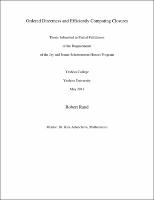Please use this identifier to cite or link to this item:
https://hdl.handle.net/20.500.12202/4204Full metadata record
| DC Field | Value | Language |
|---|---|---|
| dc.contributor.author | Rand, Robert | |
| dc.date.accessioned | 2018-11-12T20:16:28Z | |
| dc.date.available | 2018-11-12T20:16:28Z | |
| dc.date.issued | 2011-05 | |
| dc.identifier.uri | https://hdl.handle.net/20.500.12202/4204 | |
| dc.identifier.uri | https://ezproxy.yu.edu/login?url=https://repository.yu.edu/handle/20.500.12202/4204 | |
| dc.description | The file is restricted for YU community access only. | |
| dc.description.abstract | Implications of the form A→B (read “A implies B”) feature prominently in multiple fields of mathematics and computers science. In mathematical terms we may define A→B as a mapping from one set to another. In Database Systems, A→B is called a functional dependency and indicates that an assignment of values to set A uniquely determines the corresponding values in set B. For example, a specific value in the “Unique_Course_Code” field of a university database might determine the corresponding Subject and Instructor. In Artificial Intelligence, a Horn clause A→B takes on the common logical meaning “if A is true then B must be true.” Representing knowledge as Horn clauses allows us to easily derive new information from existing knowledge. When we possess large quantities of data in the form of Horn clauses, we often seek to store that data as compactly as possible. The Canonical Basis described by Guigues and Duquenne in [5] was mathematically proven to represent information using the fewest implications possible. However, the Canonical Basis is not direct, meaning that it may require many iterations of the basis to derive all the implications of a given set of data. We discuss the notion of Ordered Directness, defined in Adaricheva and Nation [1], and demonstrate in Theorems 1 and 2 that it is impossible to order the Canonical Basis, in either of its forms, in such a way that processing the implications in order will ensure that we attain all consequents via a single sweep of the basis. We additionally propose a sufficient condition for inorderability, and demonstrate in Theorem 3 that our counterexamples are the smallest ones that meet this condition. The D-Basis proposed in [1] bears the advantage of being ordered direct while being significantly shorter than existing direct bases. In sections V and VI, we carefully test three aspects of the D-Basis in order to determine its advantages and disadvantages. We compare the efficiency of deriving implications against the unit form of the Canonical Basis and the Direct Optimal Basis of Bertet and Monjardet [3]. We additionally compare the length of DBasis and its derivative E-Basis against multiple forms of the Canonical Basis and the Direct Optimal Basis. Finally, we compare the time and space efficiency of iterating through the DBasis to the popular forward chaining algorithm introduced by Dowling and Gallier [4]. We conclude in section VII by summarizing the problems generated in the course of this work, including finding the necessary conditions for inorderability, efficiently computing the D-Basis from other bases, and finding the unit basis with the smallest number of implications. | en_US |
| dc.description.sponsorship | Jay and Jeanie Schottenstein Honors Program | en_US |
| dc.language.iso | en_US | en_US |
| dc.publisher | Yeshiva College | en_US |
| dc.rights | Attribution-NonCommercial-NoDerivs 3.0 United States | * |
| dc.rights.uri | http://creativecommons.org/licenses/by-nc-nd/3.0/us/ | * |
| dc.subject | Logic programming. | en_US |
| dc.subject | Horn clauses. | en_US |
| dc.subject | Relational databases. | en_US |
| dc.subject | Closure operators. | en_US |
| dc.subject | Lattice theory. | en_US |
| dc.subject | Computer science. | en_US |
| dc.title | Ordered Directness and Efficiently Computing Closures | en_US |
| dc.type | Thesis | en_US |
| Appears in Collections: | Jay and Jeanie Schottenstein Honors Student Theses | |
Files in This Item:
| File | Description | Size | Format | |
|---|---|---|---|---|
| Robert-Rand.pdf Restricted Access | 252.65 kB | Adobe PDF |  View/Open |
This item is licensed under a Creative Commons License

